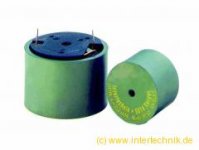Here it is, the new Mark 4 Crossover:
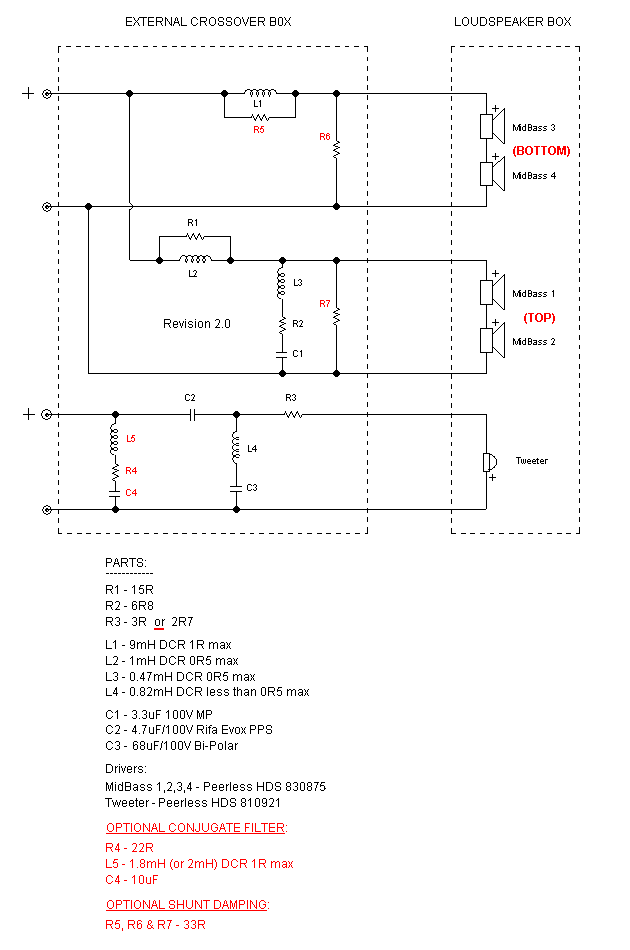
The three added 33R resistors are R5, R6 and R7 - they are listed as Optional Shunt Damping - so whether you take up that option or not, that is what distinguishes if you have Mark 3 and Mark 4.
Details will be posted here soon and on the website - the reasons why and also the option to vary (tweak) the 33R value. IF you change this value they should all three (per crossover, so a total of six) be the same. They should not be less than 33R - experimenting with values up to 100R max (above that value they will have too small an effect). Experimentation should prove quite easy to do.
I am using 33R in my Elsinores right now and very pleased with the result. So that will likely stay the official value.
The improvement largely depends on the amplifier you use. It may well have a larger improvement with valve/tube amps, especially single end and JLTi Unity Coupling Amplidiers EL34 and KT88 - where the improvement is quite dramatic.
But as the Mark 4 revision makes the load on the amplifier a lot less resistive, espcially in the 70-90 Hertz region, many solid state amplifers (not all of them like reactive loads) may also show significant improvement.
All this will come out in the wash as we get feedback.
Cheers, Joe
PS: Sometimes it's good to wear two hats. It has helped that I do both amplifier design and speaker design. Not trying to be immodest, but most speaker designers do only speakers and it is important to see things from the amplifier side too. The Mark 4 upgrade is really about the amplifier and seeing that its needs are also met.

The three added 33R resistors are R5, R6 and R7 - they are listed as Optional Shunt Damping - so whether you take up that option or not, that is what distinguishes if you have Mark 3 and Mark 4.
Details will be posted here soon and on the website - the reasons why and also the option to vary (tweak) the 33R value. IF you change this value they should all three (per crossover, so a total of six) be the same. They should not be less than 33R - experimenting with values up to 100R max (above that value they will have too small an effect). Experimentation should prove quite easy to do.
I am using 33R in my Elsinores right now and very pleased with the result. So that will likely stay the official value.
The improvement largely depends on the amplifier you use. It may well have a larger improvement with valve/tube amps, especially single end and JLTi Unity Coupling Amplidiers EL34 and KT88 - where the improvement is quite dramatic.
But as the Mark 4 revision makes the load on the amplifier a lot less resistive, espcially in the 70-90 Hertz region, many solid state amplifers (not all of them like reactive loads) may also show significant improvement.
All this will come out in the wash as we get feedback.
Cheers, Joe
PS: Sometimes it's good to wear two hats. It has helped that I do both amplifier design and speaker design. Not trying to be immodest, but most speaker designers do only speakers and it is important to see things from the amplifier side too. The Mark 4 upgrade is really about the amplifier and seeing that its needs are also met.
another change needed?
In the PDFs of Scan-Speak’s D2608 Discovery tweeter and the Peerless HDS 810921, there are differences.
While the 810921’s PDF was stamped Preliminary, and has a lot less specs, the Sensitivity may not be as high - though the 810921 didn’t say if it was @ 2.83 V/ 1m.
More importantly, the response at 30 and 60 degrees apparently now drops off faster . .
In the PDFs of Scan-Speak’s D2608 Discovery tweeter and the Peerless HDS 810921, there are differences.
While the 810921’s PDF was stamped Preliminary, and has a lot less specs, the Sensitivity may not be as high - though the 810921 didn’t say if it was @ 2.83 V/ 1m.
More importantly, the response at 30 and 60 degrees apparently now drops off faster . .
Attachments
Joe,
Would this help reduce the bass bloom experienced when we plugged a tube amp into my Elsinores recently (which I assume was just because of lack of dampening)?
YES! To the first part.
The second part re damping is more complex.
Indeed that (first part) was what motivated the change. But it turned out to do somewhat more than that.
The difference with solid state amp is yet to be verified.
No it was not damping perse'. It is more to do with lessening the reactive Q associated with the Z plot and reacting to that.
Here are some graphs that shows the differences caused by now going to Mark 4.
The first shows only a minore change to the frequency response. Red is old Mark 3 and Blue is Mark 4:
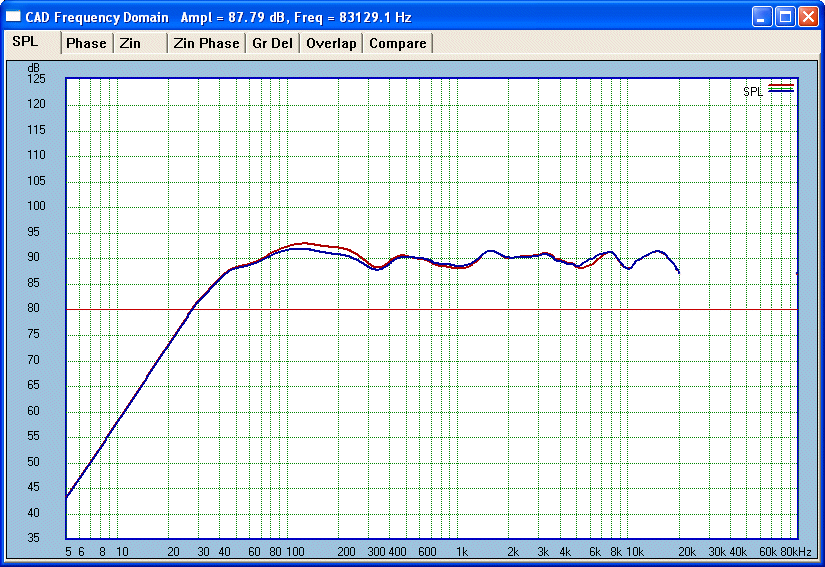
Not a great change in frequency response.
Let us look at the difference in the Z plot, the impedance curver:
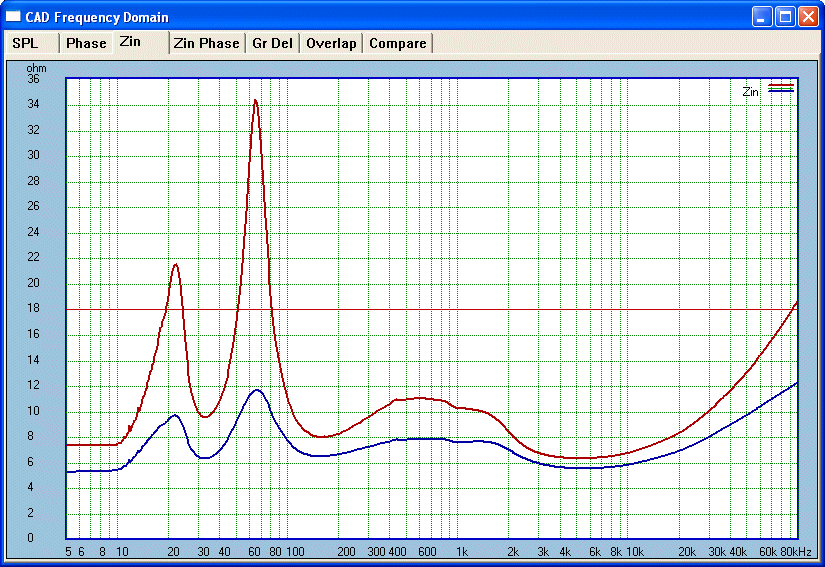
The overall impedance is lower, but does not drop so low as to invalidate the 8 Ohm rating.
What is more significant is what it does to the electrical phase. Keep in mind that dropping below the line seen in the graph below indicates capacitive and hence potentially reactive load:

We can see the Blue Mark 4 is quite a lot flatter and hence more resistive. But look at 80 Hertz, the negative phase angle in halved, now that is a good thing.
Now let us explore what happens when the Elsinores are driven from a higher impedance amplifier. The below examples simulates 5 Ohm output impedance which is what the JLTi EL34 amp approximates. Most Single-Ended amps, of the tube variety, will also behave similarly, they are all Unity Coupling amps as the output impedance is similar or near that of the speaker's Z.
Below: Red represents a "voltage" amp - one with an impedance well below 1 Ohm, theoretically 0 Ohm. The Blue represents 5 Ohm source Z.
First for Mark 3:
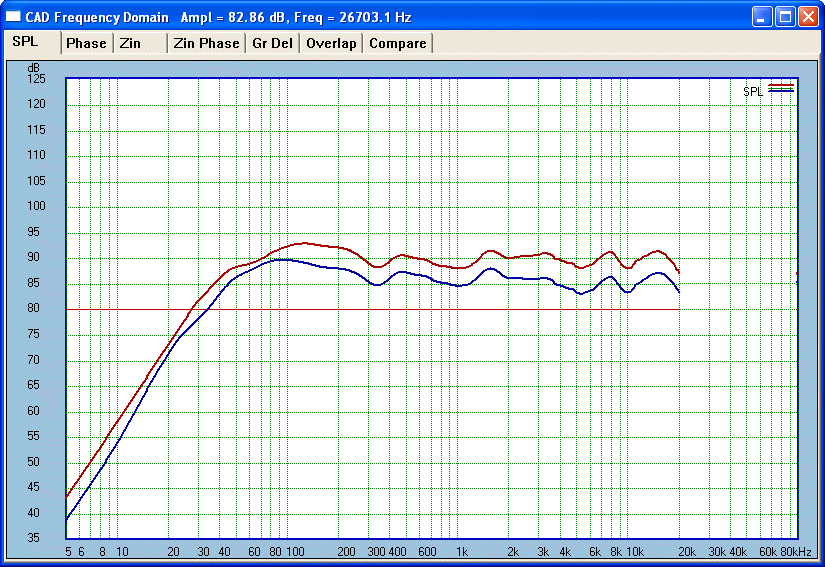
Look at round 80-100 Hertz, see how the lines close up. There is certainly more output with Blue (5R) than Red (0R). It will certainly sound richer, but also reacting to other things revealed above.
Now let at look at Mark 4 and how it has improved:
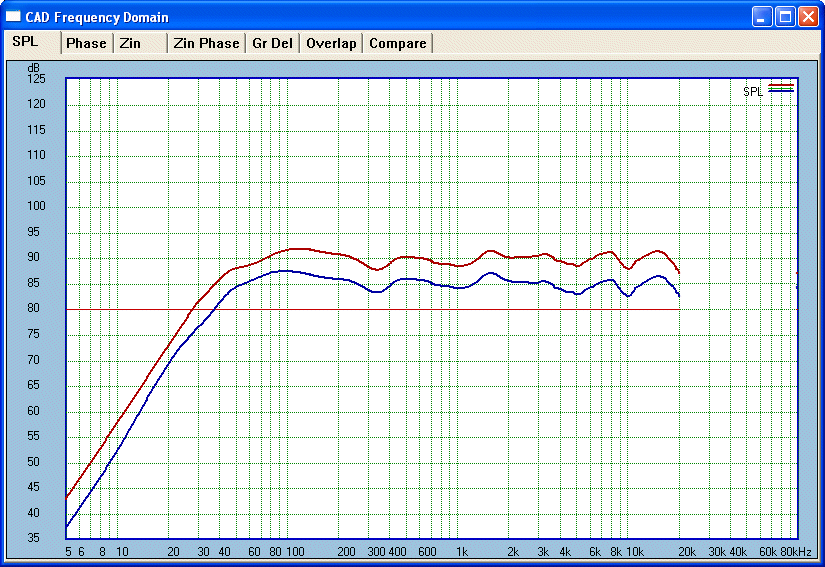
Now the addition 5R representing the Unity Coupling amp has very little difference between the two responses. You have to look hard to see there is much a difference.
We would need to see that this also corresponds by comparing the Z plots:
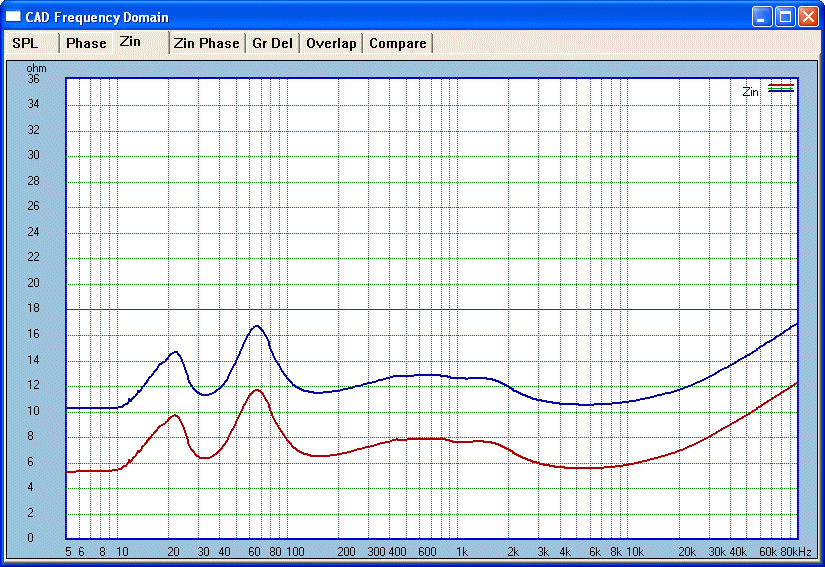
Again the shape is well retained.
Final conclusions:
The improvements clearly audible go well beyond that of frequency responses. To describe as damping is too simple. I am not saying that damping is not a factor here, just that there is a lot other things going on. The load conditions imposed on the amplifier and how it copes, also the linearity of the amplifier under dynamic conditions. We now understand that we are much more sensitive to dynamic shadings under a few hundred Hertz than we are the rest of the audio range. We may be less sensitive (but only relatively less) to distortion than compared to critical 2KHz. But the ear/brain uses AGC action to compress dynamics centered around 2KHz but at lower frequencies it is dynamics we sense more acutely. If there is any lag, or any excess energy (damaging downwards dynamics), and these can be caused by so many things (did anybody say power amplifer power supplies?). It comes down to the amp's linear response to dynamics and it's ability to deal with load conditions imposed on it.
The Elsinore simply becomes more amplifer friendly - and it seems both the Elsinores and the amplifier repays in kind. It is just the bass clarity that is improved, but there is also a remarkable improvement in the way the midrange is projected. But again this will depend on what amplifier marriage you have.
Cheers.
Joe R.
In the PDFs of Scan-Speak’s D2608 Discovery tweeter and the Peerless HDS 810921, there are differences.
While the 810921’s PDF was stamped Preliminary, and has a lot less specs, the Sensitivity may not be as high - though the 810921 didn’t say if it was @ 2.83 V/ 1m.
More importantly, the response at 30 and 60 degrees apparently now drops off faster . .
Actually the differences do not concern me too greatly. The Z plot looks identical, the characteristic 6-7KHz droop is both there and so is the 14KHz, the high-pass slope (and shape) is not that dissimilar.
I took the graphic of one and expanded it vertically in a paint program to match the visual aspect ratio of the other and it then started to look much closer. The biggest difference is that the raggedness of the 60 degree off axis on D2608 - wouldn't loose to much sleep over that (they could have used a little more smoothing) - I never measure that far off anyway.
They may have revised the dBSPL @ 1M rather than the tweeter. This measurements is always difficult to get right. Even complete speaker systems are difficult to measure and specify the voltage sensitivity.
Speaker measurements change, that doesn't mean the tweeter has changed, not other than batch differences.
If you think the sensitivity has dropped, then slightly lower R3. BTW, this is an 8 Ohm tweeter - to get where it is, it is still drawing half the current and hence have the power, considering that most tweeters are 4 Ohm (some are even 3 Ohm if you ask me). So you get +3dB for free.
Cheers.
Joe
Hi Guys
In about a week I will be able to supply really decent set of 6 Dale Vishay 33 Ohm resistors that are required to update from Mark 3 to Mark 4. These are of the type I use my my Elsinores and also crossovers I have built for others.
The cost including shipping will be $30 AUD. PayPal will be OK.
Contact me first and don't send any $ until I confirm stock. I should have enough to supply six sets on a first come first serve basis.
Cheers.
Joe R.
In about a week I will be able to supply really decent set of 6 Dale Vishay 33 Ohm resistors that are required to update from Mark 3 to Mark 4. These are of the type I use my my Elsinores and also crossovers I have built for others.
The cost including shipping will be $30 AUD. PayPal will be OK.
Contact me first and don't send any $ until I confirm stock. I should have enough to supply six sets on a first come first serve basis.
Cheers.
Joe R.
Last edited:
Hi Dr. ?????????????
Never been called that. The best I'd be able to be called is an honourable Doctor.
Anybody seen any spare Doctorates lying around?
You don't mention which Harbeth? But if you are talking about the Harbeth sound, then I would say that you would like the Elsinores. What more can I say.
Cheers.
Joe R.
Never been called that. The best I'd be able to be called is an honourable Doctor.
Anybody seen any spare Doctorates lying around?
You don't mention which Harbeth? But if you are talking about the Harbeth sound, then I would say that you would like the Elsinores. What more can I say.
Cheers.
Joe R.
Hi Guys
I just got an email from somebody is the land of the Swiss who has upgraded his Mk3 Elsinores to Mk4. He has graciously allowed me to post it here.
Cheers.
Joe R.
------------------------------------------------------------
Hi Joe
Yesterday evening, after work, I did the MK4 modification with R33 Vishay Dale wirewound resistores type RH 10 aluminium housing. Today I'm a bit tired as I almost could not stop listening last night as with each further CD played the sound settled in better and better (as it always does after new soldering). Especially bass notes, acoustic or electric, are much better defined and controlled, the sound of the string and body are now clearly separated. Mids and top end improved too by more clarity. At the weekend I will have more time to analyse all the benefits in detail but already now I can highly recommend this modification.
Kind regards
Hans
I just got an email from somebody is the land of the Swiss who has upgraded his Mk3 Elsinores to Mk4. He has graciously allowed me to post it here.
Cheers.
Joe R.
------------------------------------------------------------
Hi Joe
Yesterday evening, after work, I did the MK4 modification with R33 Vishay Dale wirewound resistores type RH 10 aluminium housing. Today I'm a bit tired as I almost could not stop listening last night as with each further CD played the sound settled in better and better (as it always does after new soldering). Especially bass notes, acoustic or electric, are much better defined and controlled, the sound of the string and body are now clearly separated. Mids and top end improved too by more clarity. At the weekend I will have more time to analyse all the benefits in detail but already now I can highly recommend this modification.
Kind regards
Hans
I recently stumbled upon this design, and it is interesting for me for it's small footprint and low bass extension. As for any diy, it's difficult for me to determine the improvement I might get in my system. Right now, I am running with Zaph ZD5 floor standing variant, and I also have Linkwitz Plutos. Has anyone been able to compare Elsinores with ZD5 or Plutos?
Air core when possible
I used a 14 ga Goertz air foil inductor for L2 - I figured that I wanted L2 to be top notch since most of the music goes through L2 to the mid range pair.
The cost of an air core/foil on L1 was more than I wanted to spend, especially at resistances suitably low for high curent bass. For L1 I used ERSE 14 Gauge "Super Silicon Grain Orientated Steel Core Q Coils" for $19.50 each - very nice.
Do other builders have different advice? I don't know what the effect is of my choices compared to some other arrangements.
Does it mean we can use ferrite core inductors for big ones, L1 and L2?
I used a 14 ga Goertz air foil inductor for L2 - I figured that I wanted L2 to be top notch since most of the music goes through L2 to the mid range pair.
The cost of an air core/foil on L1 was more than I wanted to spend, especially at resistances suitably low for high curent bass. For L1 I used ERSE 14 Gauge "Super Silicon Grain Orientated Steel Core Q Coils" for $19.50 each - very nice.
Do other builders have different advice? I don't know what the effect is of my choices compared to some other arrangements.
Actually, for L2 I can get away with 1mm wire on air and still have a reasonable price at 6eur and DCR=0.60R. For L1, I plan to use bell core inductor of 10mH, and unwind it to 9mH, unless there are reasonable objections 
For 68uF cap I plan to use cheap bipolar.
For 68uF cap I plan to use cheap bipolar.
Attachments
I have more or less read the whole thread, and I did not see the inductor core requirement, just L and DCR. Does it mean we can use ferrite core inductors for big ones, L1 and L2?
I think you are getting some pretty good information from the others. Effectively L1 is seeing a nominal 16 Ohm load and a good ferrite core inductor will do the job effectively while keeping the physical size down to something manageable and reasonable expensive. But if somebody desires to go for a massive air core, then that is their choice. But I have always used ferrite cores.
L2 should be air core, what choice is up to you whether you want to go for something really expensive or exotic, but a good air cored inductor does the job. I don't want to specify high cost components as I know the Elsinores does very well with crossovers that are quite affordable.
Cheers.
Joe R.
Hello Joe
In respects to your crossover design; knowing that all 4 drivers are wired to launch a cohesive signal forward much lik a large 2way,could these same principles apply to a 3way? Having 3drivers working there respective bandwidths from 3 seporate chambers? My question centers around the midrange (5"midbass) and the bandpass network. By using the data from the mid-band responce could one eliminate some componants of a by using a parallel (LR contour network) and roll this energy off similar to the two upper Peerless in the Elsinore project? Then one could use a single inductor on the woofer, correct?
Then one could use a single inductor on the woofer, correct?
Regards,
Francis
In respects to your crossover design; knowing that all 4 drivers are wired to launch a cohesive signal forward much lik a large 2way,could these same principles apply to a 3way? Having 3drivers working there respective bandwidths from 3 seporate chambers? My question centers around the midrange (5"midbass) and the bandpass network. By using the data from the mid-band responce could one eliminate some componants of a by using a parallel (LR contour network) and roll this energy off similar to the two upper Peerless in the Elsinore project?
 Then one could use a single inductor on the woofer, correct?
Then one could use a single inductor on the woofer, correct?Regards,
Francis
Hello Joe
In respects to your crossover design; knowing that all 4 drivers are wired to launch a cohesive signal forward much lik a large 2way,could these same principles apply to a 3way? Having 3drivers working there respective bandwidths from 3 seporate chambers?
Yes, separate chambers.
If doing a 3-way and want minimum/controlled phase, then I would use Butterworth provided the crossover is well below 1KHz. This crossover would sum at -3dB and the bass and mid drivers should be well within their piston range and at least and octave or more below and above the crossover frequency. That means they will be in the same phase. But the crossover between mid and tweeter should follow the Renegade Tweeter Theory, where the Tweeter now is reversed electrical phase, but taking advantage that the Tweeter's high rise time reverses the acoustic phase. This crossover, like the Elsinore's, should sum at -6dB.
My question centers around the midrange (5"midbass) and the bandpass network. By using the data from the mid-band responce could one eliminate some componants of a by using a parallel (LR contour network) and roll this energy off similar to the two upper Peerless in the Elsinore project?Then one could use a single inductor on the woofer, correct?
I really could not give specific answers to all that. But on the bass I'd use a single inductor but unlike the Elsinores I'd likely use a Zobel to cancel out the bass driver's inductance and aim for a controlled first order acoustic low pass. The Elsinores are different in this respect in that they were deliberately not a first order roll-off, but sub 1st order. This isn't suitable in a 3-way. The Elsinores bottom two drivers, identical to the mids above, can be used up higher than the bass driver in a 3-way, which must be rolled off properly. They are used in the Elsinores to keep sensitity high, among other things.
Cheers.
Joe R.
- Home
- Loudspeakers
- Multi-Way
- The "Elsinore Project" Thread
